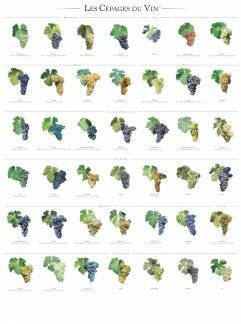This is a question which bugged me since few times: what are the most widely planted grapes in the world ? And, like a miracle, the answer came, not from the sky but from…Australia !
 Of course, it’s a question which, after all, worries only wine lovers. But if you are reading this article, the answer could interest you. The suspense is at its height 😉 Lately, an Australian academic team from Adelaïde created a database of grapes planted in the world. After going over more than 500 wine areas with a fine-tooth comb and 1271 cepages (remind us of the International Organization of Vine and Wine takes an inventory of 5916 cepages, whose you can obtain the world distribution here), this team drew up a full scene of the most widely planted cepages in the world, describing the progression since 2000. And without surpise, you know it all…or almost ! The winners of this ranking 2010 are:
Of course, it’s a question which, after all, worries only wine lovers. But if you are reading this article, the answer could interest you. The suspense is at its height 😉 Lately, an Australian academic team from Adelaïde created a database of grapes planted in the world. After going over more than 500 wine areas with a fine-tooth comb and 1271 cepages (remind us of the International Organization of Vine and Wine takes an inventory of 5916 cepages, whose you can obtain the world distribution here), this team drew up a full scene of the most widely planted cepages in the world, describing the progression since 2000. And without surpise, you know it all…or almost ! The winners of this ranking 2010 are:
10. Pinot noir : 86 662 ha (+45 %), so 2 % of the world’s vineyard. It is the emblematic cepage of the Burgundy’s red.
9. Trebbiano Toscano blanc : 109 772 ha (-20 %), so 2 % of the world’s vineyard. Known as Ugni Blanc in France, it is used to elaborate the Cognac, but the balsamic vinegar too in Modene.
8. Sauvignon blanc : 110 138 ha (+70 %), so 2 % of the world’s vineyard. Pessac-Léognan, Pouilly-Fumé, Quincy or Cloudy Bay (New-Zealand), so much designations glorified by this cepage.
7. Black Grenache: 184 735 ha (-14 %), so 4 % of the world’s vineyard. From Spain, where it is called Garnacha.
6. Syrah : 185 568 ha (+83 %), so 4 % of the world’s vineyard. My ragweed, my pet, the Valley Rhone goes to it so well.
5. Chardonnay : 198 793 ha (+37 %), so 4 % of the world’s vineyard. The fancy cepage, fundamental to sold a bad white wine…
4. Tempranillo: 232 561 ha (+150 %), so 5 % of the world’s vineyard. Not the first, but the most impressive increase of the last 10 years, it gave birth to a “new wave” of spanish wines, losing speed at that time.
3. Airen: 252 364 ha (-35 %), so 5% of the world’s vineyard. The surprise, the unknown. The most widely cepage in 2000, it lost 2 ranks. One’s man loss is another man’s gain (Tempranillo), because it suffered of the incredible increase of the previous cepage.
2. Merlot: 267 169 ha (+26 %), so 6 % of the world’s vineyard. This cepage, named from the blackbird “merle”, whose the colour reminds the grapes, is famous thanks to the Bordeaux’s right bank, including Saint-Emilion.
1. Cabernet sauvignon: 290 091 ha (+31 % par rapport à l’an 2000), so 6 % of the world’s vineyard. Bordeaux did imitators and our winner invaded the world, under the influence of Margaux, Saint-Estèphe and Pauillac.
And if you are more curious, this is the detail of the 50 most widely planted cepages in the world. But, this exhaustive list is not really useful if we don’t ask us the meaning of that. After all, isn’t worrying to see a standardisation of the world wine making ? Is the lure of profit the main motivation of the world’ vineyard ?

Hopefully, thanks to the action of few men, like Philippe MEYER (above), the forgotten cepages or disappeared regain thanks to the created in 2010 in Aveyron (at Saint-Côme-d’Olt). This year, it takes place the 8th and 9th of November and the success proves consistent. The goal ? It’s better to leave him the speaking: “The idea went to speak about them (Note: the unknown wine-makers), a world with few audience. The most erudites of us started to talk of these forgotten cepages or disappeared which made the wine’s France.”
THANK YOU and congratulations for this initiative !




